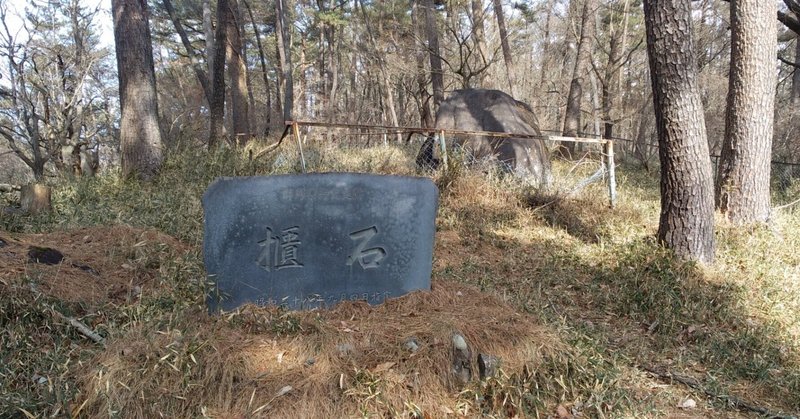
櫃石探訪記
「赤城の山も今宵限り」という国定忠治のセリフや上毛かるたにも読み込まれ、群馬県のシンボルとも言えそうな赤城山。その山に点在する赤城神社の一つである三夜沢赤城神社。その奥の院とでも言えそうな場所へと古代の信仰形態の跡を求めて、足を伸ばしてみました。
まったくの余談ですが、この神社には神隠しの伝説があり、近い所では1998年に千葉県から家族と共に参拝に来た主婦が行方不明になったという事件があり、テレビ番組でも取り上げられて、話題になったことがありました。
それはさておき、まずは探索の無事を祈願に拝殿へ。鳥居をくぐると右手に泉と手水舎。しかし、今の時代の定番もしくは茶番と言うべきか、柄杓はなく手水の使用は出来ません。神社に来て手を浄めずに参拝というのも釈然としない。更には猿轡の着用とシュッシュッの使用を促す看板。屋内ならまだしも、オープンスペースで意味あるのか疑問。しかも参拝者もさして多くないのに。
拝殿に近づいていくと右隅にあるのが以前、こちらでも記事にしたことがある古代文字の石碑。
参拝の後、いよいよ今回のメインたる櫃石目指して出発。
ここから約2キロの山道を辿ることになります。幾つか道には分岐がありますが適切に案内板があるので迷うことはありません。
オートキャンプ場の横を通り、緩い登り勾配を進む。此処は上州、からっ風の里というこいとで冷たい風が始終、吹いている。やがて、フタコブラクダのような絵を発見。
車が通れる筈もない山道だが、登山者用の交通標識ということらしい。凹凸ありという意味か。
「行く手を阻む数多くの倒木」川口浩探検シリーズめいたアナウンスを脳内で呟きつつ更に進む。
それまで耳に入るのは風の音と、自分が下げている熊除けの鈴の音のみだったのが、いよいよ頂上近くなってくると、妙なる調べが。
ハーモニカ?どうやら曲名は「瀬戸の花嫁」
神社参拝に行き、其処から音楽が聞こえてくると歓迎されている印という話を聞いたことがるが、どうやら櫃石様からの歓迎?
目指す場所に辿り着くと先客。年配の男性。
「此処で人に会うのは珍しい」とのこと。
「お気を付けて」というお言葉を頂き、男性は先に下山。
ゆっくりと探索に入る。
鎮座しているのは櫃石と呼ばれる巨石。古代人は巨石や岩を信仰の対象としていました。磐座と呼ばれるのがそれで、この櫃石もそうした一つ。名前の通り、お櫃に似ているような。
こうした磐座の近くに社が建てられるようになっていった、そうした形態が歴史ある神社には多い。三夜沢赤城神社も延喜式に記載されている古社なので、それに当てはまる。
三夜沢赤城神社自体が結構な山の中にありますが、この櫃石は更に山奥。此処を信仰の場とした古代人。登って来るのも大変だったことでしょう。それだけの時間と労力をかけなければ参拝出来ないということも真価だったか。
平らなてっぺんに丁度、日光が当たり、何やら神々しい。
巨大な櫃石の後方には、一回り程小さな石が二つ。これらも磐座の一部だったのでしょう。
そちらを観察すると、もしかすると盃状穴?
盃状穴とはその名の通り、岩に穿った盃状の穴。古代人は其処に供物を納めたという説があり、またハワイでは子孫繫栄を祈り、盃状穴に新生児の臍の緒を納める風習があったとか。そうした南洋から船を仕立てて渡来した海民がこんな山奥に至り、信仰の場を築いたとしたら?そんな妄想が膨らんできます。
岩石信仰、そして盃状穴ということはペトログラフもあるかも?と思って見回しましたが、残念ながら見つからず。そう簡単に見つかれば、とっくに発見されてますね。
三夜沢赤城神社、社殿の周辺は鬱蒼とした杉林に囲まれて、陰の気が漂っているようにも感じますが、櫃石は日光が降り注ぐ陽の気が溢れる場所。そんな感慨を抱きながら下山。
動画をこちらからご覧下さい。
English version.
Mt.Akagi is famous for Kunisada Chuji's word,
"I have to say good bye to Mt.Akagi"
or for Jomo karuta, a popular card game among Gunma people.
There are some Akagi shrine in the mountain. I visited one of them, Miyosawa-Akagi shrine and the deepest place of it to see the object for the worship in the ancient.
It is a digression but this shrine has a legend. It says some people were missed in the shrine. In 1998, a housewife from Chiba came here with her family disappeared. That incident was featured on a TV program and became famous.
Back to the track. First I walked to the main shrine to pray for the safe trip.
Over the Torii gate, on the right, there is a fountain and a basin to purify.
But as many shrines do, there were no scoops so we are not allow to use it. I felt strange we can't purify before praying. And I saw another sign board it said that please wear a mask and use disinfectant.
I wonder it is really useful because we were in the open air space. And there were not so many visitors.
approaching the main shrine, on the right there is the stone monument of the ancient characters. You can read details from the link.
After I prayed, I started hiking for the main place of that day, Hitsuishi. From here I had to walk about 2 kilo meter. On the way to there, there were some signs so it was not hard to get to it.
After I passed the side of an auto camp site, went up on the slope. I was blowing by cold wind, as they say there is strong wind around Gunma prefecture.
I found a traffic sign looked like a bactrian camel. I guess it was for walkers not for cars. I guess it told us there were some unevenness.
"There are many tumbled trees in front of me"
I spoke only in my head like TV program "Adventures of Kawaguchi Hiroshi"
I had heard the sound of wind and the ring to avoid bears from my backpack,
but as I was approaching the summit, I heard the sound of music.
It must be the sound of harmonica. And the tune was "The bride of Seto"
I heard that if you hear the music from a shrine it is the sign deity welcomes you. So this sound must be the sign from the stone.
I reached there I met an aged man with playing harmonica.
"It is rare to see someone on this spot"
He said.
"Take care of yourself"
Then he went down after that I saw and prayed the stone.
Hitsu means a container for cooked rice. As the name, it looked like it.
People in the ancient days worshiped big stones or rocks like it.
Such ones are called Iwakura.
They began to build shrines near such stones or rocks. It is the origin of some shrines which have a long history. Miyosawa-Akagi shrine was listed in Engishiki which was the ancient list of shrines, so it must be one of them.
The shrine is in the deep mountain but the stone was in the much deeper place. I guess the ancient men must be tough enough to climb up and worship it. It was worth to use their time and power.
The top of it was illuminated by the sunlight. I felt a kind of divine.
Behind the Hitsuishi, there were 2 stones those were little bit smaller. Those must be Iwakura too.
I found some holes on them. Those might be Cuples.
Cuple is cup like hole on rocks. They say the ancient men offered something for deity in such holes. And in Hawaii, native people offered umbilical cord of new born baby to pray for descendants prosperity.
I imagined such people from the south pacific came to Japan and got to the deep mountain and worshiped the stone. It might be only my delusion but it is fun.
Worship for the stone and Cuples so there might be some petrograph but unfortunately I couldn't find it. If it was easy to find, someone had found already.
Miyosawa-Akagi shrine was surrounded by many cedar trees so I felt it is a kind of dark but the Hitshuishi was illuminated by the sunlight, I felt the blight.
Then I went down.
You can see the video on youtube.
この記事が気に入ったらサポートをしてみませんか?
